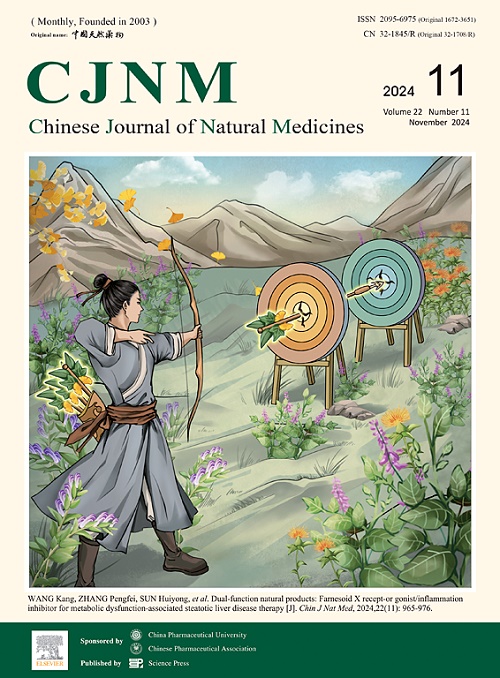Xiaohuang Qudan decoction alleviates ANIT-induced cholestatic liver injury by inhibiting the JAK2/STAT3 pathway and regulating TH17/Treg
IF 4.9
2区 医学
Q1 INTEGRATIVE & COMPLEMENTARY MEDICINE
引用次数: 0
Abstract
Xiaohuang Qudan decoction (XHQDD) is a classical traditional Chinese medicine (TCM) formula widely used in the treatment of cholestatic liver injury. Despite its widespread use, the protective mechanism of XHQDD against cholestatic liver injury remains incompletely understood. The aim of this study was to investigate whether XHQDD mediates its beneficial effects by inhibiting the Janus kinase 2 (JAK2)/signal transducer and activator of transcription 3 (STAT3) pathway and regulating TH17/Treg balance. To this end, the researchers used Sprague-Dawley (SD) rats and established a cholestatic liver injury model by oral administration of alpha-naphthylisothiocyanate (ANIT). The experimental group was divided into six groups: Control (CON), ANIT, ursodeoxycholic acid (UDCA), XHQDD-low dose (XHQDD-L) group, XHQDD-medium dose (XHQDD-M) group, and XHQDD-high dose (XHQDD-H) groups. Then, after 7 d of treatment, various tests were performed to verify the results. Firstly, XHQDD and its drug-containing serum were analyzed by ultra-high performance liquid chromatography-mass spectrometry/mass spectrometry (UPLC-MS/MS), and 14 blood-entry components were identified. Then, bile flow was monitored and found to be significantly reduced in the model group, which was significantly reversed in the UDCA and XHQDD groups. To further assess ANIT-induced liver injury, hematoxylin and eosin (H&E) and Sirius red staining, alongside transmission electron microscopy (TEM), were employed to observe liver tissues, revealing hepatocellular injury, cholestasis, and hepatic fibrotic changes. Serum inflammatory factors and liver injury indicators were assessed using enzyme-linked immunosorbent assay (ELISA), indicating an inflammatory state in ANIT-induced liver injury rats. The expression levels of JAK2/STAT3-related genes and proteins in liver and intestinal tissues were measured via quantitative reverse transcription polymerase chain reaction (qRT-PCR), immunohistochemistry, immunofluorescence (IF) staining, and Western blottting (WB) assays. These studies revealed that the inflammatory state of liver-injured rats was inextricably linked to the inflammatory cascade associated with the JAK2/STAT3 pathway and that XHQDD may exert anti-inflammatory efficacy by inhibiting the JAK2/STAT3 pathway. Flow cytometry was used to determine the percentage of T helper 17 (Th17)/regulatory T (Treg) cells in serum and hepatocytes, and it was further found that XHQDD was able to regulate Th17/Treg immune homeostasis in liver-injured rats. The findings suggest that XHQDD markedly alleviates inflammation in ANIT rats, potentially treating cholestasis and liver injury through JAK2/STAT3 inhibition and Th17/Treg balance regulation.
小黄祛胆汤通过抑制JAK2/STAT3通路和调节TH17/Treg通路减轻anti诱导的胆汁淤滞性肝损伤
小黄祛胆汤(XHQDD)是广泛应用于治疗胆汁淤积性肝损伤的经典中药方剂。尽管广泛使用,但XHQDD对胆汁淤积性肝损伤的保护机制仍不完全清楚。本研究旨在探讨XHQDD是否通过抑制Janus kinase 2 (JAK2)/signal transducer and activator of transcription 3 (STAT3)通路和调节TH17/Treg平衡来介导其有益作用。为此,研究人员选用SD大鼠,通过口服α -萘基异硫氰酸酯(ANIT)建立胆汁淤积性肝损伤模型。实验组分为对照组(CON)、ANIT组、熊去氧胆酸组(UDCA)、xhqdd -低剂量组(XHQDD-L)、xhqdd -中剂量组(XHQDD-M)、xhqdd -高剂量组(XHQDD-H)。然后,在处理7 d后,进行各种试验来验证结果。首先采用超高效液相色谱-质谱联用/质谱联用(UPLC-MS/MS)对XHQDD及其含药血清进行分析,鉴定出14种血源性成分;然后监测胆流量,发现模型组胆流量明显减少,UDCA和XHQDD组胆流量明显逆转。为了进一步评估anit诱导的肝损伤,采用苏木精伊红(H&;E)和天狼星红染色,并结合透射电镜(TEM)观察肝组织,发现肝细胞损伤、胆汁淤积和肝纤维化改变。采用酶联免疫吸附试验(ELISA)评估血清炎症因子和肝损伤指标,提示anit诱导的肝损伤大鼠处于炎症状态。采用定量逆转录聚合酶链反应(qRT-PCR)、免疫组化、免疫荧光(IF)染色、Western blotting (WB)检测肝脏和肠道组织中JAK2/ stat3相关基因和蛋白的表达水平。这些研究表明,肝损伤大鼠的炎症状态与与JAK2/STAT3通路相关的炎症级联有着千丝万缕的联系,XHQDD可能通过抑制JAK2/STAT3通路发挥抗炎作用。流式细胞术检测血清和肝细胞中辅助性T 17 (Th17)/调节性T (Treg)细胞的百分比,进一步发现XHQDD能够调节肝损伤大鼠的Th17/Treg免疫稳态。研究结果表明,XHQDD可显著缓解ANIT大鼠炎症,可能通过抑制JAK2/STAT3和调节Th17/Treg平衡来治疗胆汁淤滞和肝损伤。
本文章由计算机程序翻译,如有差异,请以英文原文为准。
求助全文
约1分钟内获得全文
求助全文
来源期刊

Chinese Journal of Natural Medicines
INTEGRATIVE & COMPLEMENTARY MEDICINE-PHARMACOLOGY & PHARMACY
CiteScore
7.50
自引率
4.30%
发文量
2235
期刊介绍:
The Chinese Journal of Natural Medicines (CJNM), founded and sponsored in May 2003 by China Pharmaceutical University and the Chinese Pharmaceutical Association, is devoted to communication among pharmaceutical and medical scientists interested in the advancement of Traditional Chinese Medicines (TCM). CJNM publishes articles relating to a broad spectrum of bioactive natural products, leading compounds and medicines derived from Traditional Chinese Medicines (TCM).
Topics covered by the journal are: Resources of Traditional Chinese Medicines; Interaction and complexity of prescription; Natural Products Chemistry (including structure modification, semi-and total synthesis, bio-transformation); Pharmacology of natural products and prescription (including pharmacokinetics and toxicology); Pharmaceutics and Analytical Methods of natural products.
 求助内容:
求助内容: 应助结果提醒方式:
应助结果提醒方式:


